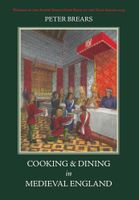Advertisement
The Buttery and Pantry
By Peter Brears
Published 2008
It is uncertain when butteries and pantries first began to be set up at the lower end of the hall. The first appearance of these words according to the Oxford English Dictionary is in 1389 and 1300 respectively, but archival evidence suggests a much earlier date. In the twelfth century,
In the cellar or storeroom [i. e. buttery] should be casks, tuns, wineskins, cups, cup cases, spoons, ewers, basins, baskets, pure wine, cider, beer, unfermented wine, mixed wine, claret, nectar, mead, pear wine, red wine, wine from Auvergne, clove-spiced wine for gluttons whose thirst is unquenchable…. In the pantry let there be shaggy towels, tablecloths, and an ordinary hand towel which shall hang from a pole to avoid mice. Knives should be kept in the pantry, an engraved salt cellar, a cheese container, a candelabra, a lantern, a candlestick, and baskets [for carrying the bread?].

